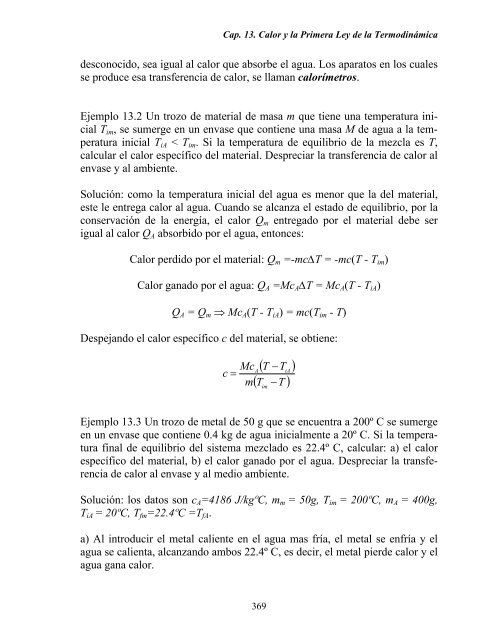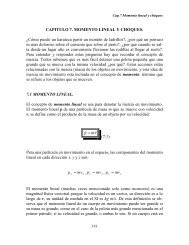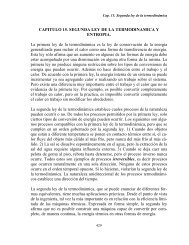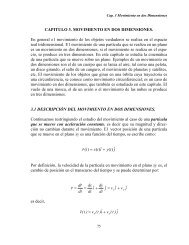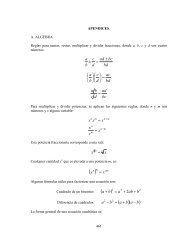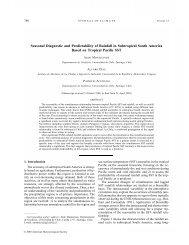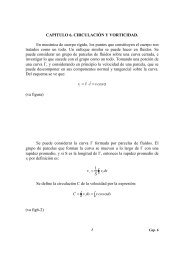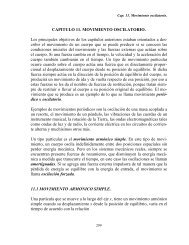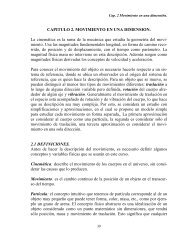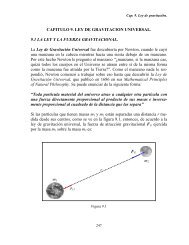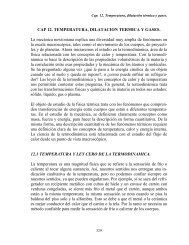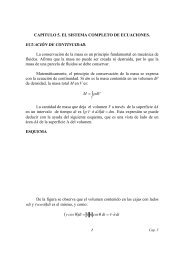Capítulo 13. Calor y la primera ley de - DGEO
Capítulo 13. Calor y la primera ley de - DGEO
Capítulo 13. Calor y la primera ley de - DGEO
Create successful ePaper yourself
Turn your PDF publications into a flip-book with our unique Google optimized e-Paper software.
Cap. <strong>13.</strong> <strong>Calor</strong> y <strong>la</strong> Primera Ley <strong>de</strong> <strong>la</strong> Termodinámica<br />
<strong>de</strong>sconocido, sea igual al calor que absorbe el agua. Los aparatos en los cuales<br />
se produce esa transferencia <strong>de</strong> calor, se l<strong>la</strong>man calorímetros.<br />
Ejemplo <strong>13.</strong>2 Un trozo <strong>de</strong> material <strong>de</strong> masa m que tiene una temperatura inicial<br />
Tim, se sumerge en un envase que contiene una masa M <strong>de</strong> agua a <strong>la</strong> temperatura<br />
inicial TiA < Tim. Si <strong>la</strong> temperatura <strong>de</strong> equilibrio <strong>de</strong> <strong>la</strong> mezc<strong>la</strong> es T,<br />
calcu<strong>la</strong>r el calor específico <strong>de</strong>l material. Despreciar <strong>la</strong> transferencia <strong>de</strong> calor al<br />
envase y al ambiente.<br />
Solución: como <strong>la</strong> temperatura inicial <strong>de</strong>l agua es menor que <strong>la</strong> <strong>de</strong>l material,<br />
este le entrega calor al agua. Cuando se alcanza el estado <strong>de</strong> equilibrio, por <strong>la</strong><br />
conservación <strong>de</strong> <strong>la</strong> energía, el calor Qm entregado por el material <strong>de</strong>be ser<br />
igual al calor QA absorbido por el agua, entonces:<br />
<strong>Calor</strong> perdido por el material: Qm =-mc∆T = -mc(T - Tim)<br />
<strong>Calor</strong> ganado por el agua: QA =McA∆T = McA(T - TiA)<br />
QA = Qm ⇒ McA(T - TiA) = mc(Tim - T)<br />
Despejando el calor específico c <strong>de</strong>l material, se obtiene:<br />
Mc<br />
c =<br />
m<br />
( )<br />
A T −TiA<br />
( T −T<br />
)<br />
Ejemplo <strong>13.</strong>3 Un trozo <strong>de</strong> metal <strong>de</strong> 50 g que se encuentra a 200º C se sumerge<br />
en un envase que contiene 0.4 kg <strong>de</strong> agua inicialmente a 20º C. Si <strong>la</strong> temperatura<br />
final <strong>de</strong> equilibrio <strong>de</strong>l sistema mezc<strong>la</strong>do es 22.4º C, calcu<strong>la</strong>r: a) el calor<br />
específico <strong>de</strong>l material, b) el calor ganado por el agua. Despreciar <strong>la</strong> transferencia<br />
<strong>de</strong> calor al envase y al medio ambiente.<br />
Solución: los datos son cA=4186 J/kgºC, mm = 50g, Tim = 200ºC, mA = 400g,<br />
TiA = 20ºC, Tfm=22.4ºC =TfA.<br />
a) Al introducir el metal caliente en el agua mas fría, el metal se enfría y el<br />
agua se calienta, alcanzando ambos 22.4º C, es <strong>de</strong>cir, el metal pier<strong>de</strong> calor y el<br />
agua gana calor.<br />
im<br />
369


